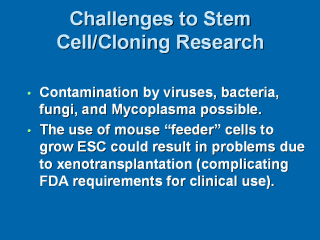| front |1 |2 |3 |4 |5 |6 |7 |8 |9 |10 |11 |12 |13 |14 |15 |16 |17 |18 |19 |20 |21 |22 |23 |24 |25 |26 | 27|28 |29 |30 |31 |32 |33 |34 |35 |36 |37 |38 |39 |40 |41 |42 |43 |44 |45 |46 |47 |48 |review |
 |
Like all immortal cell lines, embryonic stem
cell lines must be protected and checked for contamination with viruses,
bacteria, fungi, and Mycoplasma. The use of infected lines in patient
treatment could have devastating effects. Many embryonic stem cell lines are
grown using mouse feeder cells. The mouse cells help the embryonic lines to
grow, but pose risks for transplantation due to compatibility problems in
human bodies.¹ Reference ¹ Kennedy, Donald. 2003. Stem Cells: Still Here, Still Waiting. Science 300: 865. |